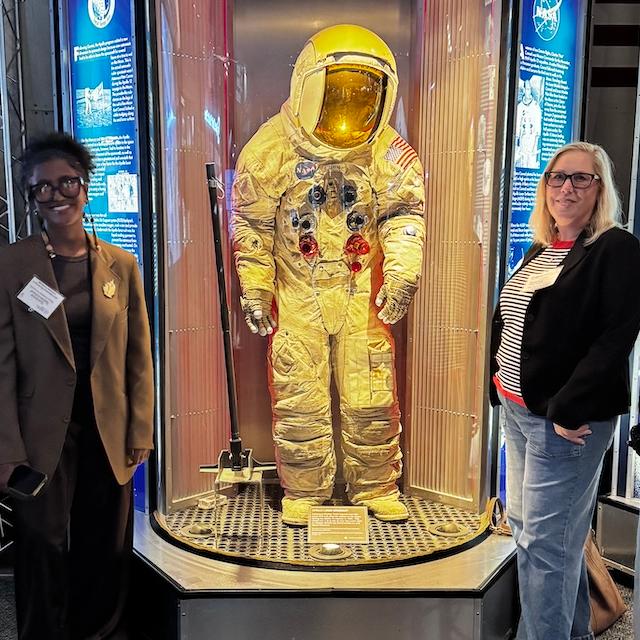
From left, Daisy Li, Suzanna Tesfamicheal, Leslie Browning-Samoni and Amarige “Sunny” Yusufji
Innovation in Orbit: TCU Team Designs for NASA’s Future
Fashion met science recently as an interdisciplinary team of undergraduate students won the 2025 Best Innovation Award at the Johnson Space Center in Houston by competing in the prestigious Technology Collaboration Center Wearables Workshop and University Challenge. The event was held during the Spaceflight Human Optimization Conference hosted by NASA.
The team’s project, “Optimized Suit Environmental Protection Garment Seams,” focused on a critical issue in future lunar missions: designing flexible, low-profile seams that prevent the intrusion of hazardous lunar dust. The goal was to reduce or eliminate dust penetration without using coatings or tapes — developing a durable, dust-resistant solution suitable for extravehicular activity spacesuits.
“I was excited to be a part of a bigger project and something that has a real-world application,” Amarige “Sunny” Yusufji, a biochemistry major, explained. “It’s sometimes difficult to see the effects of your work in organic chemistry research, but working on this project has shown me that my work will have an impact on the world.”
Also on the team were fellow biochemistry major Daisy Li and fashion merchandising majors Suzanna Tesfamicheal, a John V. Roach Honors student, and Adelaide Lovett, a dual degree student in psychology. The team was led and mentored by Leslie Browning-Samoni, instructor II in fashion merchandising.
“This competition was the perfect example of interdisciplinary problem-solving,” Browning-Samoni said. “Our students combined creativity and scientific method to prototype something meaningful for real-world space exploration.”
Browning-Samoni played a central role in guiding the team through the entire research
and development process, including selecting materials, creating and refining seam
constructions, developing the testing procedure and ultimately leading the team to
Houston for the final presentation.
“This was the first project that I felt like I was actually in control of the research design and how we produced results. Working with fashion merchandising students was incredible. I loved meeting people outside of my major, as they’ve had a very different TCU experience than I have. Now, I’m inspired to take a few sewing classes before I graduate!”
— Amarige “Sunny” Yusufji
Mentorship and Innovation
Initial recruitment support came from Kayla Green, chemistry professor, who helped
bring together students across disciplines. Stephanie Bailey, senior instructor of
fashion merchandising, provided additional guidance in seam exploration, working with
the team to investigate a wide range of seam types before narrowing the focus to three
for testing: French, flat-felled and a custom-engineered “mutant” seam.
Throughout the process, the team was mentored by Felix Arwen, a softgoods engineering technologist at NASA. While this was his first year mentoring for the TCC Challenge, he previously participated in the program as a student and has served as a mentor for other NASA challenges.
“I know firsthand the value of a good mentor and how much of a difference it can make to have someone who can be a resource with firsthand experience, who can challenge your assumptions and help guide your ideas into reality,” Arwen said.
Under his guidance, the students developed seam prototypes using high-performance fabrics such as Kevlar, Teflon and polyurethane-coated textiles, sewn with either polyester or nylon thread. Then Lovett started sewing.
“I began sewing polyurethane-coated fabric samples to get initial feedback,” Lovett said. “Working with Samoni and the rest of the fashion merchandising team, we standardized every detail — seam construction, stitch length, needle type — to make sure our tests were controlled and meaningful.”
Each sample was tested with Lunar Highlands Simulant, or LHS-1, in an eight-hour tumbling procedure designed to mimic the motion and wear of extravehicular activity, the maximum duration for such missions. The samples were flipped halfway through to simulate cross-directional exposure and ensure realistic dust penetration at various seam angles.
To visualize dust accumulation, the team received support from Rhiannon Mayne, the Oscar and Juanita Monnig Endowed Chair of Meteoritics and Planetary Science in the College of Science & Engineering. She assisted with high-resolution photography using the microscope at the Monnig Meteorite Gallery, confirming varying levels of dust retention across seam types and fabrics.
A Glimpse into NASA’s Future
At the challenge, the team delivered a formal pitch to NASA judges and presented their
work during an interactive session with conference attendees. Their exhibit featured
a scientific poster, seam samples, a slideshow and microscope imagery of the dust-impacted
materials.
“This was the first project that I felt like I was actually in control of the research design and how we produced results,” Yusufji said. “Working with fashion merchandising students was incredible. I loved meeting people outside of my major, as they’ve had a very different TCU experience than I have. Now, I’m inspired to take a few sewing classes before I graduate!”
Lovett was also encouraged by her cross-discipline team.
“To be a part of such an amazing team, and to be supported by incredible faculty advisors was such a fabulous opportunity,” Lovett said. “I think that beyond science and fashion, NASA is a symbol of innovation and reaching for greatness. So, to be invited and to be able to present the work we have all worked so hard on is such a fulfilling achievement in and of itself.”
After the challenge, the team concluded with a tour of NASA’s facilities, including the Space Vehicle Mock-up Facility and Arwen’s lab, offering students a behind-the-scenes look at real-time innovations in astronautics.
“I was impressed by how the group stayed committed to a project that was entirely extracurricular,” Arwen said. “They were able to put together a great final project and proved a concept for seam constructions that shows real promise and will likely be developed further by me and my team.”
Support for the undergraduate research project and funding for travel was provided by the College of Fine Arts and the College of Fine Arts Gala Funds for Student Experiences.
